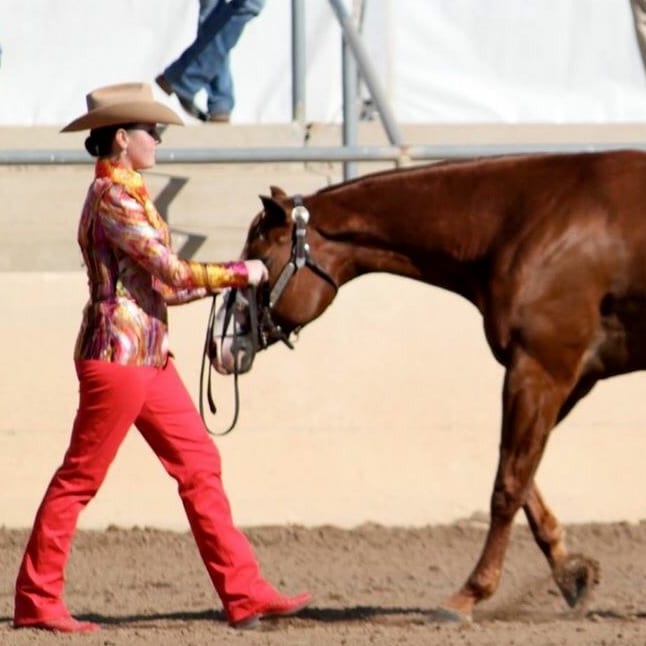If you happened to watch the AQHYA World Show this year, you may have seen Sydney Scheckel and her mare, A Perfect Pleasure, deliver a nearly flawless performance in the Showmanship.
Without a doubt, one of the most memorable moments of Scheckel’s pattern was her back. It was straight, it was balanced, it was rhythmic, and it showcased an exhibitor and a horse who were both natural and talented.
Sometimes, riders overlook the quality of their back and focus more on achieving perfection in other maneuvers, like a lead change or a pivot. However, watching someone like Scheckel perform at the AQHYA World Show this year proves that a perfect back can “wow” both the judges and the crowd and should be something that is routinely practiced at home so it can be perfect in the show pen.
GoHorseShow sat down with Scheckel’s trainer and AQHA judge Bruce Walquist to discuss the importance of the back, mistakes people make, and he even shared some of his secrets to help those who struggle with getting the perfect back.
What Makes a Good Back
The first thing that usually comes to mind when people think of a “good back” is a straight line.
And, of course, backing straight is a critical element in the maneuver. But, it isn’t the only thing a person should focus on when it comes to a “perfect” back.
“A horse that lifts its back up, drops its neck, stays soft [in the halter or bridle], and backs with a steady rhythm and tempo is a horse that has a good back,” said Walquist.
This means you have an additional four elements to consider in addition to getting that straight line.
For Walquist, it doesn’t matter if you are showing in Showmanship, Horsemanship, or Equitation, the elements of a perfect back remain the same and the ability to master this maneuver displays one’s ability to control the horse.
“Even though you see horses backing in the pasture, they are more of a forward moving animal,” he said.
This forward moving mentality suggests that backing is not the most natural thing for a horse to do and as riders and handlers it is up to us to make it look natural.
Walquist says the key “is that the horse responds to the person. You want a horse that is responsive and not resistant.”
Backing to Perfection in Showmanship
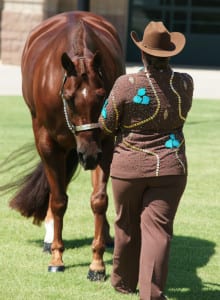 While the elements of a perfect back remain the same on the ground and in the saddle, the techniques on how to get there are slightly different.
While the elements of a perfect back remain the same on the ground and in the saddle, the techniques on how to get there are slightly different.
Walquist said, “The biggest mistake I see with the back in the Showmanship is a horse that doesn’t respect or respond to a person’s body. Horses like this inevitably move left or right and the back ends up being crooked.”
Because of this, it isn’t surprising that Walquist prefers his horses to back off the person’s body instead of off the chain. He also believes horses who back off the body exhibit softness in the halter, a quality that is revered for a good score on the back.
However, he was very clear that “it’s [also] fine to have a horse who backs lightly off the chain. In that case, it’s just a matter of style preference. But a horse that is heavy on the chain and the person is physically pushing them back, that’s when you see heads fly up and backs start getting crooked.”
For those who are used to backing their horses off the chain and want to make the switch, Walquist recommends using a dressage whip or even your hand to aide in teaching your horse to back off the body.
“You can tap your horse (lightly) between their front legs to encourage them to back away from you,” he said, “or if using your hand, swing it under the neck toward the horse and that will also encourage them to back away from you.”
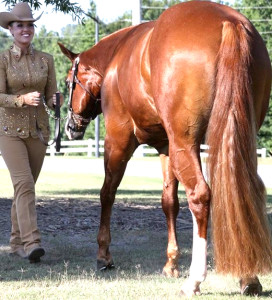 He likened the idea to having a hula hoop around your waist. The hoop represents your personal space. When you swing your hand under the neck toward the horse you are conveying to them that they are infringing on your space and to back off.
He likened the idea to having a hula hoop around your waist. The hoop represents your personal space. When you swing your hand under the neck toward the horse you are conveying to them that they are infringing on your space and to back off.
Eventually, a horse will learn to back when you move toward them which in turn allows for the all the right moves (lifted back, dropped neck, soft, etc.) because they are being responsive and not resistant.
Walquist also shared a few other tips in regards to getting the perfect back in Showmanship.
“I like the distance between the exhibitor and the horse’s head to remain the same throughout the entire back,” he said, “This shows rhythm and helps keep a tempo.”
He also cleared up any confusion about where to look when asking your horse to back: over the top line.
“If you look over the top of the horse, it is easier to tell how straight you are backing and you can easily adjust by moving your body left or right to keep your horse backing straight.”
Bonus: This works exceedingly well if your horse is trained to back off your body and not the chain.
Backing to Perfection in the Saddle
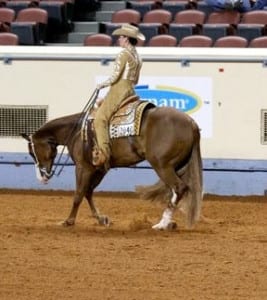 When it comes to Horsemanship, Walquist said the most common mistake he sees is a rider pulling their hand up too fast and too hard, resulting in a horse that is resistant to the back.
When it comes to Horsemanship, Walquist said the most common mistake he sees is a rider pulling their hand up too fast and too hard, resulting in a horse that is resistant to the back.
Not surprisingly, Walquist likes pattern horses to back off a person’s legs, similar to Showmanship horses backing off the person’s body.
“Horses can be taught to back off a person’s legs,” he said, “and it can either be that they back when you release your legs from them or put a light contact to them and cluck, it doesn’t matter. The point is, they respond to your legs.”
Walquist explained that in order for a horse to back off legs with just a light contact you need to make sure the horse is broke first. In other words, your horse needs to be flexible and give to the bridle so you DON’T have to hang on the reins to get them to back.
“A horse has to be flexible in the chin and break at the poll for a good back,” he said. “Lateral flexion causes vertical flexion.”
However, Walquist emphasized that this should be backed up (no pun intended) with a light contact with the reins.
“I’m not a fan of draped reins in pattern classes,” he said, “you need to maintain contact with the horse in order to execute [all] the maneuvers.”
And of course, it’s not all about the horse.
Walquist said, “Riders should drop their eyes, not their chin, to look between the horse’s ears when they go to back. Then you can see how the head and neck are moving to help you. Riders also need to be square in the saddle.”
The Importance of Stopping Square
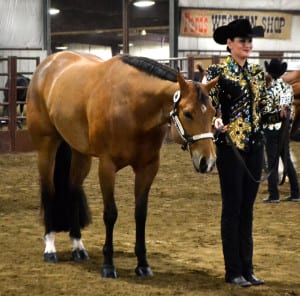 Speaking of square, one thing that remains consistent for Walquist when it comes to achieving the perfect back (in every class), is to try and make sure your horse stops square every time.
Speaking of square, one thing that remains consistent for Walquist when it comes to achieving the perfect back (in every class), is to try and make sure your horse stops square every time.
“When a horse stops square, they are ready to go into the next maneuver,” he said, “they are balanced. With my horses, they learn that when they stop and aren’t square, they want to balance themselves automatically. I like for my horses to help a little bit.”
Like pretty much everything else in riding, the only way Walquist says to make this happen is with repetition.
“[On the ground] you can stop and square up a lot so it just becomes second nature for the horse,” he said.
This idea may be familiar to many but what about in the saddle?
“It’s all about the timing of the rider,” Walquist said, “they have to learn to stop their horse on the upbeat; when the horse’s hind end is going under them. The goal is to have the horse stop with both back feet square.”
He continued, “At home, if the horse doesn’t stop with both hind feet square, we back them up a few steps. When they do, we let them stand and rest.”
Lastly, Walquist iterated that the back is a maneuver just like anything else and judges will judge every maneuver. Even though it doesn’t carry any direct penalties (unless you just don’t do it), if your back isn’t very good, you risk a minus on your maneuver score, possibly even two minuses.
Therefore, it isn’t any less important than any other maneuver in a pattern class, no matter what it is.


